17 results
Common Core WHST.9-10.9 laboratories
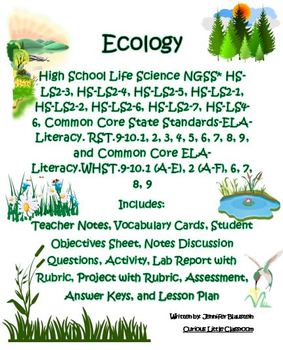
High School Life Science Biology- Ecology
This lesson is compatible with the High School Next Generation Science Standards* HS-LS2-3, HS-LS2-4, HS-LS2-5, HS-LS2-1, HS-LS2-2, HS-LS2-6, HS-LS2-7, and HS-LS4-6. The standards ask that the students, “[c]onstruct and revise an explanation based on evidence for the cycling of matter and flow of energy in aerobic and anaerobic conditions, [u]se mathematical representations to support claims for the cycling of matter and flow of energy among organisms in an ecosystem, [d]evelop a model to illus
Subjects:
Grades:
9th - 12th
Types:
CCSS:
NGSS:
HS-LS2-3
, HS-LS2-7
, HS-ETS1-3
, HS-LS2-5
, HS-LS2-4
...
Also included in: High School Life Science Biology- Ecology and Evolution Bundle!!!

High School Life Science Biology- Ecology and Evolution Bundle!!!
These ecology lessons are compatible with the High School Next Generation Science Standards* HS-LS2-3, HS-LS2-4, HS-LS2-5, HS-LS2-1, HS-LS2-2, HS-LS2-6, HS-LS2-7, and HS-LS4-6. The standards ask that the students, “[c]onstruct and revise an explanation based on evidence for the cycling of matter and flow of energy in aerobic and anaerobic conditions, [u]se mathematical representations to support claims for the cycling of matter and flow of energy among organisms in an ecosystem, [d]evelop a mod
Subjects:
Grades:
9th - 12th
Types:
CCSS:
NGSS:
HS-LS2-3
, HS-LS2-7
, HS-LS2-5
, HS-ESS3-3
, HS-LS4-2
...

Inquiry Based Lesson Plans for High School Psychology: Mini Bundle
Are you looking for inquiry based lesson plans for high school psychology that get your students actively engaged in the content? This self-directed, inquiry-based, psychology-themed mini-bundle has you covered.This bundle includes two inquiry resources that go hand-in-hand. One is a self-directed project-based learning experience where each student chooses one psychologist (historical or present-day) to explore. Students will research the psychologist using the principles of project based learn
Subjects:
Grades:
9th - 12th
Types:
CCSS:
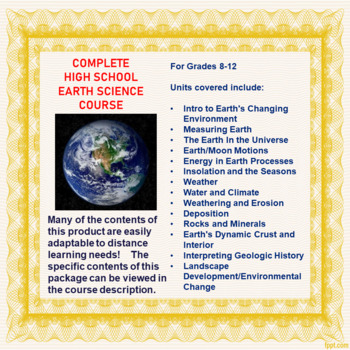
Earth Science Complete Course (Distance Learning)
The enclosed materials compose a complete Earth Science containing 14 individual units. The PowerPoints and diverse collection of learning materials contain more than 1,175 pages of materials and approximately 1,850 PowerPoint slides. The units in the package are part of the Earth Science/Physical Setting course taught in New York State, but may be used to design a dynamic Earth Science course in any high school program. The PowerPoints, completion notes, labs and other associated supporting
Subjects:
Grades:
8th - 11th
Types:
CCSS:
NGSS:
HS-ESS2-5
, HS-ESS1-6
, HS-ESS2-1
, HS-ESS1-4
, HS-ESS3-2
...

Chemistry of Life - Building Labs BUNDLE
This bundle of 3 labs includes the carbohydrate, lipid, and protein building labs. All 3 focus on demonstrating the differences between these types of organic molecules and applying those differences beyond just visual models. The students figure out how to put together models of simple carbohydrate, lipids, and proteins, and combine/break them apart to demonstrate hydrolysis and condensation reactions. Each lab has its own detailed page as well. These labs focus discussion on each type o
Subjects:
Grades:
9th - 11th
Types:
CCSS:
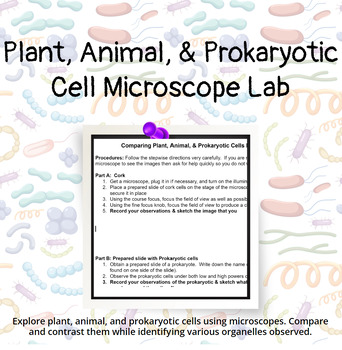
Comparing Plant, Animal, and Prokaryotic Cells Microscope Lab
This lab is perfect for an introductory biology course at the high school or college level. Its intended to be used as a way for students to explore prokaryotic and eukaryotic cell types. Students explore plant, animal, and bacterial cells under the microscope. students view cork, bacteria, cheek cells, onion, and elodea. Students sketch cells and label. This lab is designed to use elodea, but a prepared plant cell slide could easily be substituted. Students are asked to compare and contrast the
Subjects:
Grades:
7th - 12th
Types:
CCSS:
NGSS:
HS-LS1-1
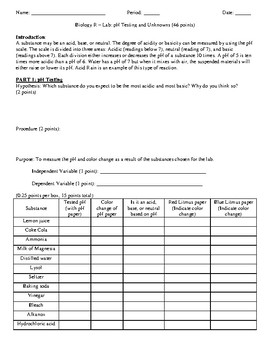
pH Testing and Unknowns Lab
This lab allows for students to work with the basics of pH by testing for the general acidity or basicity of a substance with litmus paper and the more exact pH with either pH paper or a pH probe. Students use the litmus paper as a means to just see how the paper reacts in each case, but the pH paper provides a number value to what the color change they see means. This lets them see a trend when testing the many substances, so as to see what types of substances tend to be more acidic, basic,
Subjects:
Grades:
9th - 11th
Types:
CCSS:

Chemistry of Life - Building Lipids Lab
This lab focuses on providing a visual representation of different lipids, with a focus on triglycerides, using a model building kit. The typical colors uses for each atom are black for carbon, red for oxygen, and yellow for hydrogen. However, this may vary across model building kits.Students use the modeling kits to build the glycerol backbone and 3 short fatty acid chains (based on the images in the lab), and, once done, combine them with their partner and/or other groups to make a complete tr
Grades:
9th - 10th
Types:
CCSS:
Also included in: Chemistry of Life - Building Labs BUNDLE
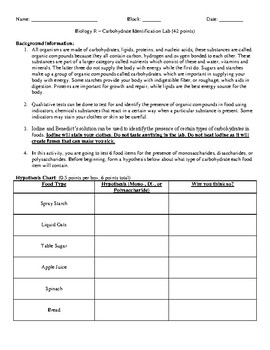
Chemistry of Life - Identifying Carbohydrates Lab (Higher Level)
In this lab, students test different carbohydrates to see how to identify each of the 3 classifications: monosaccharides, disaccharides, and polysaccharides. Students will see how iodine and Benedict's solution can be used to identify monosaccharides and polysaccharides. Disaccharides no reaction with either solution. By testing the base solutions, they known what results to expect. They then do the reactions with 6 samples to see which carbohydrate classification they each fit in. After tes
Subjects:
Grades:
9th - 10th
Types:
CCSS:
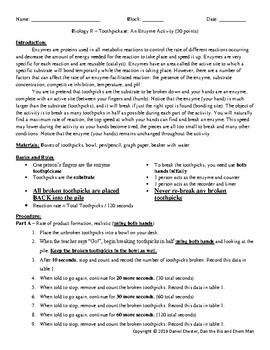
Chemistry of Life - Toothpickase Enzyme Lab
This lab focuses on a hands-on approach to understanding enzymes and enzyme function. It used toothpicks and the students' fingers breaking them to demonstrate how enzymes work. Throughout the lab students will be able to be "toothpickase", an enzyme that can break toothpicks between the fingers of one hand. The hand acts as the enzyme, and the toothpicks are the substrate. As the lab progresses, the conditions for "toothpickase" change, where paper clips act as inhibitors, using the non-do
Subjects:
Grades:
9th - 10th
Types:
CCSS:
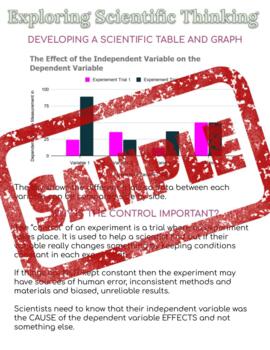
Scientific Method Scaffolding and Independent and Dependent Variables
This one of a kind resources goes into DETAIL explanations about the difference between independent variables and dependent variables in tables and graphs. In addition, sentence frames are included with concrete examples which help students compose their own hypothesis, questions, data tables and graphs using their knowledge of independent and dependent variables. A resources unlike any other found online today that is designed to teach children HOW to think like a scientist and compose scientif
Subjects:
Grades:
7th - 12th, Higher Education, Adult Education
Types:
CCSS:
NGSS:
HS-ETS1-2
, HS-LS4-3
, HS-ESS3-5
, HS-ESS3-6
, HS-LS4-4
...

Chemistry of Life - Building Proteins Lab
This lab focuses on providing a visual representation of different components of a protein, by constructing different amino acids, using a model building kit. The typical colors uses for each atom are black for carbon, red for oxygen, yellow for hydrogen, and blue for nitrogen. However, this may vary across model building kits.Students use the modeling kits to build the glycine and then choose 2 additional amino acid from the ones shown (based on the images in the lab). Once done, combine them w
Grades:
9th - 11th
Types:
CCSS:
Also included in: Chemistry of Life - Building Labs BUNDLE

Enzyme Lab with Student Writen Procedure and Lab Analysis- Common Core and NGSS
This lab uses amylase enzyme isolated from soaking pinto beans in water to allow students to investigate the function of enzymes. The teacher will demonstrate a sample set-up of the lab, but students are responsible for picking an independent variable they think will effect the function of amylase and writing a procedure to test that variable, and then performing the experiment.
I have included my lab analysis writing instructions and rubric, but even more common core standards can be addresse
Subjects:
Grades:
9th - 12th
Types:
CCSS:
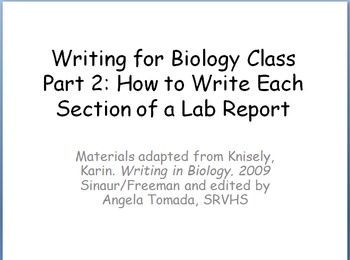
Complete Lab Report Guide for Standard Level Science Classes
Help your students to really evaluate their lab work while promoting learning using the Science and Engineering Practices in the Next Generation Science Standards (NGSS) as well as the Writing Standards for Literacy in History/Social Studies, Science and Technical Subjects (WHST) AND LIMITING THE AMOUNT OF TIME IT TAKES YOU TO GRADE IT!
This package includes everything you need to get your students on track with their lab report writing and keep them improving all year. Check out my bundle on
Subjects:
Grades:
6th - 12th
CCSS:

Complete Lab Report Writing Guide for Advanced Level Science Classes
Help your students to really evaluate their lab work while promoting learning using the Science and Engineering Practices in the Next Generation Science Standards (NGSS) as well as the Writing Standards for Literacy in History/Social Studies, Science and Technical Subjects (WHST) AND LIMITING THE AMOUNT OF TIME IT TAKES YOU TO GRADE IT!
This package includes everything you need to get your students on track with their lab report writing and keep them improving all year. Check out my bundle on
Subjects:
Grades:
6th - 12th
CCSS:
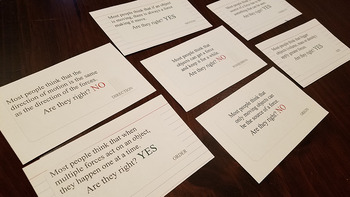
Physics Misconception Cards
These are two sets of seven questions pre-formatted to be printed on Avery 5163 (or 5263) shipping labels which can then be placed on either side of a 3x5 card. Each question can then be flipped to affirm or deny a statement related to common misconceptions related to the nature of forces. These misconception relate specifically to Origin, Possession, Motion, Order, Direction, Visibility, and Size.
These misconceptions were gleaned from the famous work by David Hestenes, Malcolm Wells, and Greg
Subjects:
Grades:
6th - 12th, Higher Education
Types:
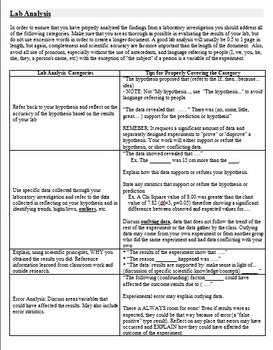
Lab Report- Short Student Analysis- Includes Rubric and Student Score Cards
Help your students to really evaluate their lab work while promoting learning using the Science and Engineering Practices in the Next Generation Science Standards (NGSS) as well as the Writing Standards for Literacy in History/Social Studies, Science and Technical Subjects (WHST) AND LIMITING THE AMOUNT OF TIME IT TAKES YOU TO GRADE IT!
This is designed for 9-12th grade, but could easily be adapted to 6-8th grade levels.
I am all about improving student literacy and writing, but often feel as
Subjects:
Grades:
6th - 12th
Types:
CCSS:
Showing 1-17 of 17 results

